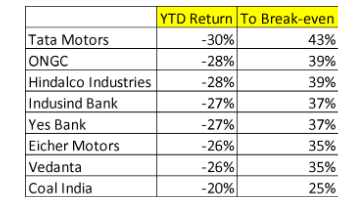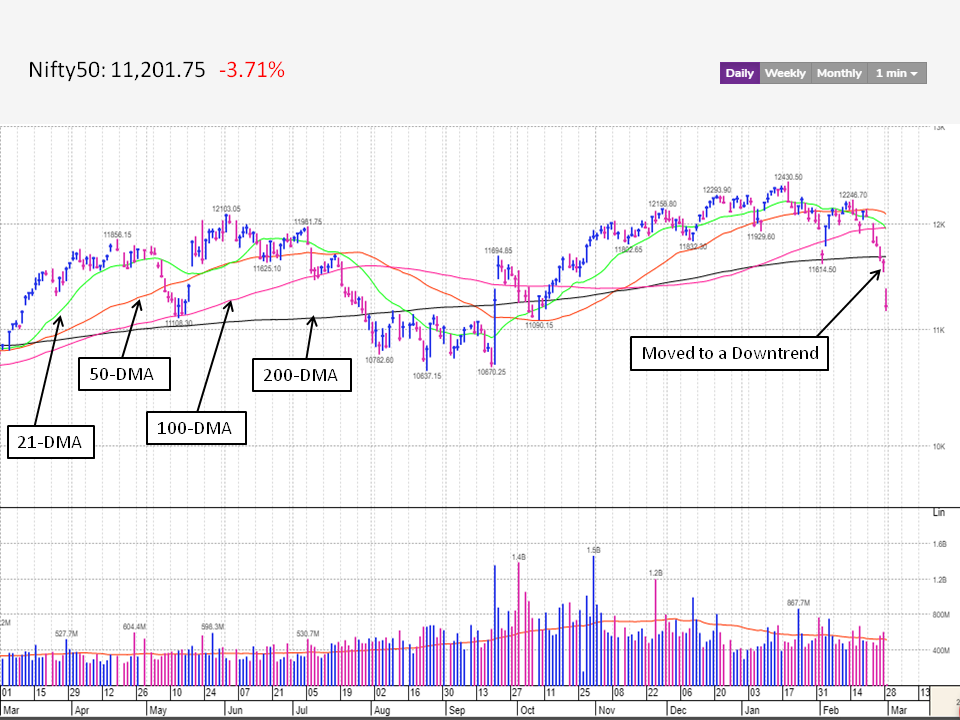Currently, the market is in a Downtrend, as Nifty is trading near its five-month low. All the sectoral indices are trading below their 50-DMA, indicating broad-based weakness. In such a scenario, it is advised to trim positions and stay in cash rather than making huge losses. The importance of taking small losses is emphasized in this article.
Highly successful stock pickers go through training on how to cut their losses short. This means selling a stock when it is down 7% or 8% from your purchase price. Sounds simple, but many investors have learned the hard way how difficult it is to master the most important rule in investing.
No one wants to sell for a loss. It is an admission that you made a mistake. But if you can set your ego aside, you can take a small loss and still be fit enough, both financially and mentally, to invest the next day. Cutting losses quickly prevents you from suffering a devastating fall that’s too steep to recover from.
The Mathematics of Investment Losses
Consider the math. Say you buy a stock at Rs 100. For whatever reason, it drops 8% to 92 during the next few days. You promptly unload it and move on. To reclaim that loss, you need to make an 8.7% gain on your next purchase with your remaining capital, which shouldn’t be hard to do.
What if you hold on?
You are sure the stock will snap back. Your research convinces you it’s worth 200, so why get scared by a minor setback?
There’s one problem. The market doesn’t care who you are, what you think or how much you believe in a stock. It says you miscalculated, at least in the short term — a message that gets louder as the stock drops 25% to 75. To get back even, now you need a 33% gain, which is much tougher to come by than that easy 8.7%.
What if the market really doesn’t like your stock and slices it in half to 50? You don’t need a calculator for this one: To recover a 50% loss requires a 100% gain. How many stocks did you pick last year that doubled in price?
The following stocks in Nifty50 have fallen more than 20% in 2020:

The second column refers to the percentage gain required to break-even from the losses made.
If you limit losses on initial purchases to 7% or 8%, you can stay out of trouble, even if only 1 out of 4 buys delivers a modest profit of 25% or 30%. You can be wrong 3 out of every 4 times and still live to invest another day.
You Can Still Win Big With Many Small Losses
Successful investors calmly take a small loss and look for the next potential winner.
So leave your emotions behind. Cutting losses with discipline will help keep your head clear when it’s time to return to the market. A great paradox of investing is that the ripest buying opportunities occur just after bear markets — when the major stock averages have declined 20% or more.
That’s exactly when most investors who haven’t cut their losses are reeling and don’t want to be hit again. It’s hard to think straight after losing thousands of dollars. But the market always recovers. What kind of shape will you be in?

Read our last week article on ‘Checklist to a Simple Investment Routine’
Disclaimer: Information contained herein is not and should not be construed as an offer, solicitation, or recommendation to buy or sell securities. It is for educational purposes only.
Performance computations reflect a time-weighted rate of return and includes a brokerage of 0.5%. All holdings are rebalanced to equal rupee amounts daily. Dividends are not considered in computations. Percent gains and losses are calculated for all issues that remain on the “Current Holdings” at the end of the day. For stocks that were added to “Current Holdings”, the basis used to calculate the percent change is the price noted when the issue appeared as a “Current Holdings” in MarketSmith India. For stocks that were removed, the selling price used to calculate the percent is the price note d when the issue appeared as “Removed” in the MarketSmith India. For more information, see our Legal disclosures here.
